Improving wheat yields on hostile soils
Take home messages
- Wheat varieties differ in their tolerance to various soil constraints.
- Parallel screening of multiple stresses, rapid field-based phenotyping, the development of a rapid root screen and the ability to screen in soil-based systems under controlled conditions using ‘model’ sodic soils representative of the target environments will generate valuable knowledge for breeding programs.
- Germplasm will be developed that will combine tolerance to the major stresses that are encountered in sodic and dispersive soils and will focus on tolerance to salinity, high pH, aluminium (Al) toxicity and waterlogging.
Background
Subsoil constraints are any soil physical or chemical characteristics located below the seedbed limiting the ability of crops or pastures to access water and nutrients. Subsoil constraints include salinity, sodicity, high soil strength and toxic concentrations of aluminium (Al) and boron (B) although a range of other factors, such as bicarbonate toxicity, nutrient deficiencies and water-logging have also been identified. Subsoil constraints occur naturally throughout large sections of the Australian grain belt, but are especially prevalent on the cropping soils of south-eastern Australia (McDonald et al., 2013). Subsoil constraints can significantly limit on-farm profitability by reducing grain yields and quality. In many soils, more than one constraint may be operating and the mixture of constraints varies across cropping regions. Grain yields can either be directly reduced by subsoil constraints (for example, high B or Al concentrations) or indirectly (for example, when poor soil structure results in waterlogging which in turn reduces crop yield). A key to improving crop productivity is to increase the root zone of crops to enable use of subsoil water located deep in the soil profile. In south-east Australia, the root zone is often considered to be to a depth of 60-100cm, yet roots are potentially capable of much deeper growth if they are able to tolerate growing with subsoil constraints.A range of engineering and farm management solutions are available to ameliorate subsoil constraints (for example, deep ripping, primer crops and subsoil manuring), but their cost and slow adoption mean that to maintain crop production in regions with subsoil constraints, a genetic approach, involving breeding cultivars with an enhanced ability to grow on affected land (Tavakkoli et al., 2012) in conjunction with the normal reclamation and management practices (Gill et al., 2008) is inevitable. Historically, little has been known about genetic variation for subsoil constraints tolerance in Australian varieties, leading to the assumption that little variation exists. This limited knowledge is also due to the practical difficulties in measuring soil constraints under field conditions due to the dynamic nature of these constraints. However, successive GRDC co-funded projects on variety improvement for sodic soils (UA00159) and management of subsoil constraints (DAN00206, DAV00149) are tackling these major methodological and knowledge gaps by developing viable managements options to improve productivity and use of plant breeding to develop better-adapted crops with improved physiological tolerance to subsoil constraints.
This paper will provide some preliminary results of a GRDC co-funded project (UA00159) aiming to increase wheat yields on sodic soils by pyramiding plant traits linked to sodicity tolerance into commercial wheat cultivars. Field trials testing cultivars of bread and durum wheat were conducted at 11 sites across Australia. The specific aim of these trials is to identify wheat cultivars with high grain yields in sodic soils and to determine the plant traits contributing to this yield.
Method
Validation of current germplasm
Identifying the right parental material is crucial for the success of the germplasm development program. While genetic variation for salinity tolerance, waterlogging, and Al tolerance has been described, this information has been derived from separate research programs with varying levels of field evaluation, much of which is regionally specific. A panel of up to 51 lines and check varieties of bread and durum wheat were grown in replicated trials in the Northern, Southern and Western regions on the targeted sodic soils. Experiments were conducted in two seasons. Local checks were included as well as a core set of lines recommended by project partners and breeders. The experiment in southern NSW was conducted at Rand. This set of trials will provide a systematic comparison of the germplasm at the same sites and between different sodic soils.
Greenhouse screening of germplasm
Using established methods, the panel of 51 lines and check varieties were evaluated in controlled greenhouse experiments with and without high B, high pH, high Al at high pH and waterlogging at germination. Various plant traits were measured including shoot and root biomass, number of roots, length of the longest root and total root length. Only results of the waterlogging screening are presented here.
Poor establishment from waterlogging can be a problem in soils that are sodic and dispersive. Waterlogging tolerance at germination was evaluated by immersing 20 seeds of each variety in water for 4 hours or 6 days at 23°C (total of 2040 seeds) and counting the number of seeds germinated each day for 8 days after the treatment. The experiment was replicated and the data used to rank each variety based on germination % after 6 days of waterlogging relative to the control (4 hours). Phenotypic data obtained from the greenhouse experiments will be combined with plant genotypic information and field trial results to select parental lines for future germplasm development.
Results and discussion
Soil constraints
Analysis of soils collected from the southern NSW (SNSW) site showed that the soil pH ranges from 5.1-8.2 with increasing sodicity (exchangeable sodium percentage (ESP) up to 30%) with depth. A dispersion test was performed on several aggregates and indicated substantial dispersion in subsoil increasing with depth (Figure 1). A considerable amount of soil water below 60cm after harvest was also found which suggests limitations to root growth reduced the crop’s ability to access subsoil water (Rengasamy et al., 2016).
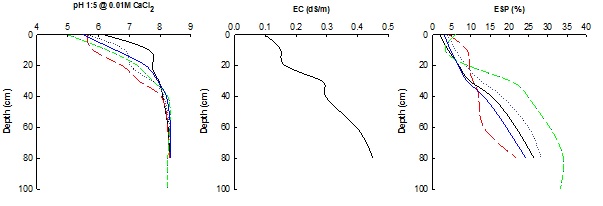

Figure 1. Selected soil characteristics of sodic site in Rand (southern NSW).
Figure 1 shows the assessment of soil dispersion at four different depths. The increasing levels of exchangeable sodium relative to calcium and/or magnesium in the subsoil results in a decrease in soil structural stability and higher dispersion as shown in Figure 1. When dispersion occurs, the dispersed clay particles fill up the pores between soil particles and aggregates and when the soil dries out, the dispersed clay blocks soil pores. This can restrict seedling emergence, water and air movement, and root penetration. Dispersed soils are generally hard-setting and may form a surface crust or concrete-like lump which can also result in waterlogging.
Variety evaluation
A summary of the 2015 yield results across all sites is shown in Figure 2. Yields ranged from less than 1t/ha at one site in Victoria to 4.4t/ha in SNSW. Figure 3 shows the degree of genetic correlation among the varieties across the sites. The important point to note from Figure 3 is the strong positive genetic correlation between the site in SNSW with sites in SA, Victoria and Katanning in WA, which indicates that results from the interstate trials are relevant to growers in SNSW. This may be because the work is targeting specific soil types (sodic dispersive soils) as well as a broadly similar pattern of rainfall across the southern region.
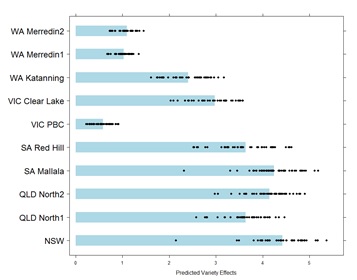
Figure 2. Predicted site yields (bars) and variety yields (dots) from the 10 sites in 2015.
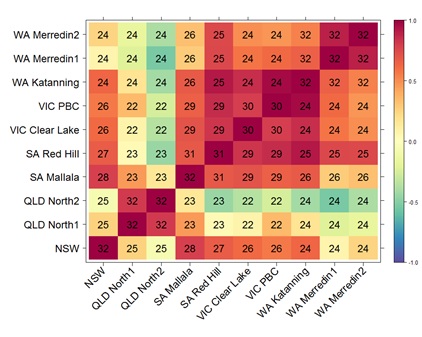
Figure 3. The heat map of genetic correlations among sites in WA, SA, Vic and NSW and Qld. Red (predominant shading) indicates a strong positive genetic correlation while blue (not present) is a strong negative correlation and green (present to a lesser degree in Figure 3) is a mild negative correlation. The two Qld sites showed strong genetic correlations but tended to differ from southern and western regions.
The detailed results of germplasm screening outlined here are from the trials conducted in SNSW. There was a wide range in plant grain yield among genotypes. Grain yield production ranged from 1.9t/ha in BH1146 (a landrace) to 5.85t/ha in Mace (Figure 4).
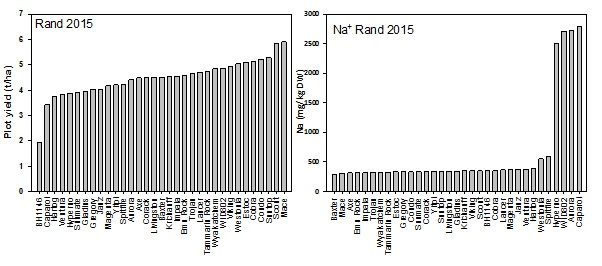
Figure 4. Variation in yield (left) and leaf sodium (Na+) concentration (right) of different wheat genotypes grown in Sodosol in Rand, southern NSW.
Variation in tolerance to 6 days of waterlogging at germination was measured between wheat varieties. In 32 of the 51 varieties tested, waterlogging reduced relative germination rates by 50% or more. A total of 12 varieties were unable to germinate following 6 days of waterlogging. Eight varieties were identified with greater than 80% germination after waterlogging including Wyalkatchem, Ventura, Sunmate, Sunco, Spitfire, LPB-Arrow, Envoy and Calingiri. Rankings presented here are based on seed waterlogged from imbibition. The occurrence of waterlogging shortly after germination (2 day old seedlings) can reduce plant growth more severely.
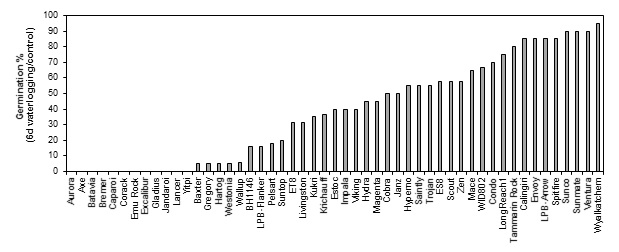
Figure 5. Wheat varieties ranked from lowest to highest germination % following six days of waterlogging relative to germination in control conditions.
Conclusions
- Subsoil constraints limit grain yield of wheat varieties in Australia.
- The preliminary results indicate a large genotypic variation exists among various varieties of bread and durum wheat which will be used to determine the plant traits contributing to yield.
- Evaluation of wheat varieties for tolerance to subsoil constraints using both field trials and greenhouse experiments is in-progress to identify suitable parental lines for future germplasm development.
References
Gill, J.S., Sale, P.W.G., Tang, C., 2008. Amelioration of dense sodic subsoil using organic amendments increases wheat yield more than using gypsum in a high rainfall zone of southern Australia. Field Crops Research 107, 265-275.
McDonald, G.K., Taylor, J.D., Verbyla, A., Kuchel, H., 2013. Assessing the importance of subsoil constraints to yield of wheat and its implications for yield improvement. Crop and Pasture Science 63, 1043-1065.
Rengasamy, P., Tavakkoli, E., McDonald, G.K., 2016. Exchangeable cations and clay dispersion: net dispersive charge, a new concept for dispersive soil. European Journal of Soil Science 67, 659-665.
Tavakkoli, E., Fatehi, F., Rengasamy, P., McDonald, G.K., 2012. A comparison of hydroponic and soil-based screening methods to identify salt tolerance in the field in barley. Journal of experimental botany 63, 3853-3867.
Acknowledgments
This research is a collaborative project between the GRDC and the University of Adelaide, NSW DPI, DAFWA, DEDJTR, UQ and SARDI. The research undertaken as part of this project is made possible by the significant contributions of growers through both trial cooperation and the support of the GRDC, the author would like to thank them for their continued support.
The authors would also like to thank Binbin Xu, Graeme Poile, Albert Oates, Vincent van der Rajit, Yan Jia and Mark Conyers (Soils Unit, NSW DPI) for technical and intellectual input towards the NSW component of the project and Lucy Cunningham (University of Adelaide) for technical support.
The authors also acknowledge Julian Taylor for statistical support of the project.
Contact details
Ehsan Tavakkoli
NSW DPI, Wagga Wagga
02 69381992
Ehsan.tavakkoli@dpi.nsw.gov.au
GRDC Project Code: UA00159,
Was this page helpful?
YOUR FEEDBACK
